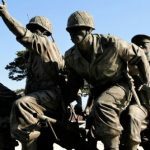 Food
Food  Food
Food  Movies and TV
Movies and TV 10 Sequels That Simply Repeat the First Film
 Technology
Technology 10 Surprising Stories Made Possible by Cutting-Edge Technology
 Animals
Animals 10 Popular Misconceptions about Dogs
 History
History 10 Unbelievably Badass Women from History
 Music
Music 10 Rock Musicians with Impressive College Degrees
 Misconceptions
Misconceptions 10 Totally Deceptive Marketing Tactics Exposed
 Movies and TV
Movies and TV 10 Amazing Facts About 10 of the Most Popular Television Shows
 History
History Top 10 Strange Ways Victorians Excercised
 Gaming
Gaming 10 Horror Games Where You Play as the Killer
 Food
Food 10 Head-Scratching Food Fads That Have (Mostly) Come and Gone
 Movies and TV
Movies and TV 10 Sequels That Simply Repeat the First Film
 Technology
Technology 10 Surprising Stories Made Possible by Cutting-Edge Technology
Who's Behind Listverse?

Jamie Frater
Head Editor
Jamie founded Listverse due to an insatiable desire to share fascinating, obscure, and bizarre facts. He has been a guest speaker on numerous national radio and television stations and is a five time published author.
More About Us Animals
Animals 10 Popular Misconceptions about Dogs
 History
History 10 Unbelievably Badass Women from History
 Music
Music 10 Rock Musicians with Impressive College Degrees
 Misconceptions
Misconceptions 10 Totally Deceptive Marketing Tactics Exposed
 Movies and TV
Movies and TV 10 Amazing Facts About 10 of the Most Popular Television Shows
 History
History Top 10 Strange Ways Victorians Excercised
 Gaming
Gaming 10 Horror Games Where You Play as the Killer
10 D-Day Facts They Don’t Teach in School
On June 6, 1944, the Allied forces invaded the Normandy region of France in an offensive that kicked off one of the bloodiest and most important parts of World War II. Of course, the invasion marked the beginning of a hard-fought campaign to liberate Western Europe from the clutches of Nazi occupation. And it was a remarkably deadly day—and campaign overall—that would see many Americans and other Allied soldiers lose their lives. Soon, it came to be known as “D-Day.”
It also (in a way) marked the beginning of the end of the war. Less than a year later, on May 7, 1945, the Third Reich signed papers copping to an unconditional surrender and a stop to all hostilities. D-Day would be the beginning of the end for Nazi Germany. Because of that, it is a hallowed day—and Normandy, hallowed ground—for those who lost loved ones in World War II or even those who merely appreciate the sacrifices those men made for their countries.
In this list, we’ll take a look at D-Day from a different perspective. Many stories are out there about the men who stormed the beaches and fought back (or died) under hails of Nazi gunfire from turrets high above. But there’s plenty more you don’t know about that important day. Here are ten little-known facts about D-Day and the men who carried out the campaign.
Related: Top 10 Historic Combat Vehicles That Changed The Face Of War
10 The Planning Took Years
Although D-Day came in June 1944, Winston Churchill and others in Europe had been thinking about it since the very start of the war. Obviously, they were rightfully concerned with Adolf Hitler’s power in Nazi Germany and aggression westward. Not wanting the Nazis to overtake all of Europe—and really not wanting the Nazis to land on the British Isles—Churchill resolved to take action early on. In October 1941, he corresponded with Captain Lord Louis Mountbatten about the possibility of an allied land invasion on the European continent. “Unless we can go on land and fight Hitler and beat his forces on land,” Churchill stated, “we shall never win this war.”
Mountbatten knew he was right, but the challenge was daunting. In April 1943, Churchill and his ilk told another British military leader—Lieutenant-General Sir Frederick Morgan—to prepare the nation’s soldiers for a full-scale assault against the continent. And then, a few months later, the Americans got involved. In December of 1943, President Franklin D. Roosevelt went to Tunis, Tunisia, to meet with then-General Dwight D. Eisenhower.
FDR told him in no uncertain terms that Eisenhower was to command the Americans and their allies in the invasion of Nazi-controlled lands in France and elsewhere in Western Europe. From there, Eisenhower started work on coordinating all the landings that were to be done at Normandy. The real battle was only just beginning—but the planning had taken nearly three full, careful, and top-secret years of whispered coordination.[1]
9 Be a Bigot… Wait, What?
When it came time to plan for D-Day, everything that had to do with the operation came under the classified term “BIGOT.” No, we’re not talking about the word “bigot” as you know it today. It didn’t mean that at all. It was actually an acronym: British Invasion of German Occupied Territory. Unfortunately for history, the acronym just so happened to spell out something not-so-great. Ah, well.
For the men who planned this invasion, though, that spelling was not a concern at all. They were more worried about any information being relayed to the Germans via spies or leaks. So BIGOT quickly became the highest level of classification of anything that had to do with World War II. Even higher up than “Top Secret,” BIGOT-related documents could only be seen by the most trusted leaders among the Allies.
Among the many (many, many) messages that were shared via the BIGOT channel, one extremely important one came through at the last minute: a delay demand. D-Day was initially supposed to take place on June 5, 1944. However, bad weather that day delayed the invasion after Allied leaders realized it would be nearly impossible to storm the beaches amid intense storms of both rain and gunfire from above. Counting on better weather on June 6, FDR and Churchill’s men tapped into the BIGOT network to push things back 24 hours.[2]
8 Why Is It Called D-Day?
The term “D-Day” was actually a relatively well-known phrase used by military outfits in the United States and elsewhere to refer to the beginning of an operation. In that term, the “D” stands for “Day,” as in the day that the event itself will take place. So to call it “D-Day” is, of course, a bit redundant. (Perhaps a few readers among us who are veterans might be saying, “That’s the military for you” at this point in the list!)
Redundancy aside, in 1944, the term “D-Day” didn’t carry the weight that it does for us history buffs now. It was used to describe the day of attack in quite a few military outings, including (but far from limited to) the invasion of the beaches at Normandy. Because of that, the Allied attack on Nazi strongholds on those French beaches was known by another, far more specific name: Operation Overlord.
That was how military officials referred to the invasion idea when they planned and executed it. It’s only years later that we now look back on it as “D-Day.” In that way, the world is able to reflect on the specific and daunting sacrifices made by those Allied soldiers on the very first and most brutal day of the invasion itself.[3]
7 A Truly Worldwide Affair
When the average history buff thinks of the Allied forces who landed on D-Day, you likely think of men from the United States and Britain. In addition, some of Britain’s former colonies surely sent men—Canada, Australia, and the like. Plus, local war-torn Western European nations wanted to help out as much as they could, so you can add France, Belgium, and the Netherlands to the list. And that’s it, right?
Well, not quite. In reality, there was a considerable contingent of soldiers on hand from several other nations that spanned the globe. Those nations included Central European sites like Czechoslovakia, northern European outliers like Norway, Mediterranean combatants from Greece, Eastern European countries including Poland, and South Pacific Ocean-based men who came all the way from New Zealand. Even tiny Luxembourg helped out! As if that wasn’t enough, men from the former British colony then known as Rhodesia—which in the modern era is called Zimbabwe—were also called on to fight.
It was truly a worldwide effort to defeat the Nazis (and Mussolini’s Italians and the Japanese). Without naval, air, and ground support from literally every nation involved, D-Day might not have been a success, and World War II might not have turned out the way it did. Heck, even with men from all those nations on hand, for a while there, it still nearly wasn’t enough to push back Hitler from the beaches.[4]
6 Hitler Wanted a Wall, Too
As we’ve learned, Winston Churchill, FDR, and other Allied leaders had been preparing for D-Day for a long time before the event actually took place. And they weren’t the only ones. For years before the eventual D-Day landings on that fateful 1944 day, Hitler had been ordering his Nazi underlings to build out a massive Atlantic Wall all along the coasts of France and the rest of Western Europe. From as far north as Norway to as far south as Spain, the Nazis spent much of the war building turrets and other defenses.
They weren’t doing it just to stay busy, either. Hitler knew that at some point, the Allies were going to try to make a move into Western Europe to wrestle back control of the territory his Nazis had occupied. So he ordered his charges to create walls, barriers, and other supposedly “impenetrable” defenses that ended up stretching for nearly 1,700 miles (2,736 kilometers) all along Europe’s western coast. Hitler wanted even more, too; he was hoping for a 2,400-mile-long (3,862-kilometer) defense from the coast of Norway all the way down through Spain.
Interestingly, a good bit of Hitler’s wall is still intact today. Many of the concrete turret defenses that the Nazis erected still stand in the modern age, either in whole or in part. Along with them, other anti-landing obstacles can still be seen up and down the long, rocky, and varied Atlantic coast of Europe. In that way, history lives on—and reminds the rest of the world about some of the horrors that came before us.[5]
5 Doing the Difficult Thing
The beaches of Normandy were not the most accessible place at which to begin the Allied invasion. In fact, it was pretty much the hardest spot. The Nazis had mapped out the entire coastline as far as potential invasions were concerned, and they determined that Normandy was by far the least likely spot where the Allies might launch their assumed attack. That’s because the beaches were set off below rocky outcroppings that gave the Nazis a naturally fortifiable position above. Plus, Normandy was one of the furthest crossing distances across the English Channel. And there was no port in the area from which the Allies could set up camp and start running logistics.
So the Nazis long assumed that the Allies would invade elsewhere. Hitler’s men just took for granted that the Allied invasion would most likely come at a place like Pas de Calais—which had a port on hand and was the shortest distance away from Great Britain through the English Channel. And as the Nazis moved to fortify all their defenses up and down the coast throughout the war, they concentrated on places like Pas de Calais far more than they did in Normandy.
Yet the Allies did invade at Normandy—and all these reasons are why they chose it. They knew the Nazis would be expecting the invasion elsewhere, and they thought Normandy would offer them the best shot at seeing a less-powerful portion of the Nazi defense units. Plus, the Normandy beaches were situated within range of air cover that British pilots could provide, which helped greatly.
And to solve the port problem, the Allies simply constructed two artificial ports. Using them, they moved thousands of tons worth of vehicles, ammunition, and other supplies daily during the beach assault. Basically, the fact that Normandy was far from perfect as a potential invasion location effectively made it the perfect, most unexpected spot from which to launch the historic event.[6]
4 Faking the News
The world has spoken quite a bit about “fake news” online over the past decade or so. But the truth is that fake news—propaganda, misinformation, deceit—has been around for a very long time. And prior to D-Day, the Allies decided to use fake news to their advantage when it came time to give Hitler the pre-invasion run-around. Even though the Allies knew they were attacking at a point in Normandy where they felt the Axis wasn’t expecting it, Churchill and the rest also knew that one small leak could ruin the entire thing. So they flooded the zone with misinformation in the months leading up to the attack in order to get the Nazis looking elsewhere before it.
Nicknamed “Operation Bodyguard,” the fake news front was working overtime for an entire year before the D-Day invasion was carried out. In particular, the final couple of months before it was chaotic. And for the Allies, they hoped it was all too confusing for Hitler’s men to figure out. The Allies sent multiple double-agent spies around to muddy the proverbial waters. Working as phony moles with bad information, they informed sources that the invasion would be taking place in other ways, at other times, and in other locations. Fake plans, fake military camps, and even bogus and secretly meaningless coded radio messages were employed to get the Germans off their trail.
And on the actual day of the invasion, the Allies went one step further. On the morning of June 6, less than a few hours before they landed at Normandy, Allied bombers ran a high-altitude bombing raid on the city of Calais, France. That was meant to give the Germans one final deception, forcing them to think the Allies were coming to the sensible spot in Calais to invade. Of course, Churchill and FDR’s men didn’t do that, and fake news helped the good guys get the drop on the beach assault.[7]
3 First by Air… Not by Sea!
Landing at Normandy is the thing the world thinks about when we reflect on D-Day. The brave Allied troops disembarking from boats (which we’ll talk about in a second), the Nazis shooting relentlessly down upon them, and the struggle to get out of the water and up the beach. But interestingly, those coming by sea were not the first Allied troops who carried out the invasion. There was an air assault that came before anything could happen at the beach.
Hours before the boats landed at Normandy, British and American joint airborne forces landed well behind German lines further inland past the sand. They were looking for the Caen Canal Bridge, which was a few miles inland from the beaches of Normandy. Their mission: to capture the area around the bridge and control it for the Allies. That would ensure that the Nazis wouldn’t be able to send reinforcement and set up a supply line as the beach battle bore on.
The Caen Canal Bridge was the only crossing point over the Orne River and the Caen Canal between the two key villages in the area, Ranville and Bénouville. So that bridge—and securing those two hamlets—was the main mission for the 6th British Airborne Division and their American counterparts. For hours, airborne assaults and later strategic landings occurred all over the region. It began just after midnight on June 6 and carried on well into the day.
As was the case with those who landed on the beach itself, the airborne units were eventually successful in their mission after a difficult, deadly ordeal. Today, the bridge has been renamed the Pegasus Bridge. Every year, locals and tourists come to the area to re-enact the events and honor the paratroopers who heroically descended from the air in the midnight hour. They must not be forgotten, but too often, they are—the first men on the front lines at the very start of the assault to take back Normandy.[8]
2 Landing Via Louisiana
When it came time for the troops to land on the beach, the Allies had a critical component on their side: Higgins Boats. Andrew Higgins was a lumber business owner and a former National Guard infantry officer who lived in Louisiana before and during World War II. His lumber work area was mostly the most rural backwoods in swampy Louisiana. And as you’d expect, he had a heck of a tough time extracting trees from those swamps. Boats he bought for the lumber biz kept running aground in shallow waters. Frustrated by years of ineffective boats, Higgins resolved to create his own. Years before World War II broke out, he started developing a new boat design. Eventually, he came up with a workable boat that could help him haul lumber out of Louisiana’s swamps.
He’d spent so much time and money on boat prototypes over the years that he was hoping to make a side business out of the push, too. There was just one problem: Although Higgins’ boats were effective at hauling trees and other heavy goods in swampy and low-tide areas, he couldn’t sell them at all. Higgins spent years trying to sell his boats with extremely little success. Just when he was ready to give up, though, the federal government showed up. They needed boats for wartime water landings, and they signed a purchase order asking for 20,000 of them. By the time they were retrofitted for the army’s specific use, they came to be known as Landing Craft Vehicle and Personnel ships. And immediately, they did exactly what the military wanted.
Higgins’ boats were front and center for all of World War II. They were used in both theaters, playing major roles in Italy, North Africa, and the tiny islands of the South Pacific, along with their critical use at Normandy on D-Day. And they changed the way the war was fought. Before, the Navy was forced to attack ports, where they could set up shop and unload logistics and men—if they could get past the heavy fortifications. With Higgins’s unique boats, they could unload on an open beach, avoid a foe’s strongest fortifications, and break through enemy lines in a relatively vulnerable spot. And in turn, the presence of these boats forced defending armies to spread themselves thin to cover more ground.[9]
1 Anne Frank Celebrated It
Amazingly, the news of the Normandy invasion even reached as far as Anne Frank. At the time, she and her family were hiding out in a tiny annex up in the attic of a building in Amsterdam. They were hoping to wait out the Nazi sweeps that were searching for Jewish people. While hiding out up there, they got word at about noon on June 6 via a BBC radio report that D-Day had arrived in Western Europe.
Jubilant about the prospect of being freed from the horrible ordeal of Nazi occupation, Anne immediately took to her diary to lay out her thoughts. “Is this really the beginning of the long-awaited liberation,” she asked herself in her youthful but incisive writing. “The liberation we’ve all talked so much about, which still seems too good, too much of a fairy tale ever to come true? Will this year, 1944, bring us victory? We don’t know yet. But where there’s hope, there’s life. It fills us with fresh courage and makes us strong again.”
Of course, Anne knew very well that she and her family wouldn’t be rescued from Nazi aggression just because D-Day had been initiated that morning. It was going to take a while for the Nazis to be pushed back out of Amsterdam and beyond. But the very fact that the Allies were on the offensive was ideal for Anne and her family. Sadly, it wouldn’t come to pass for them. Almost exactly two months later, Anne and the Frank family were found by the Nazi occupiers where they’d been hiding. She died in 1945 before the Allies could reach her concentration camp to liberate it from Nazi rule.[10]








